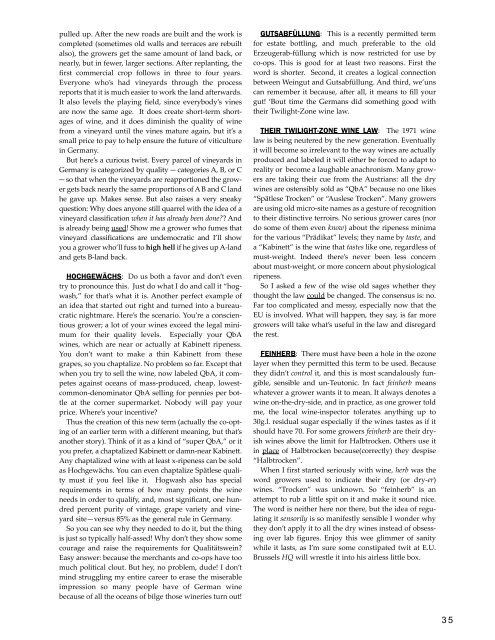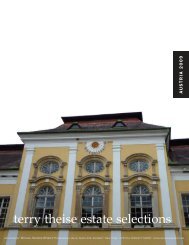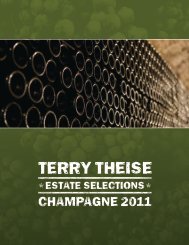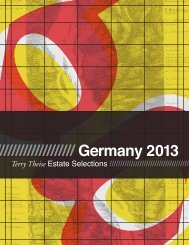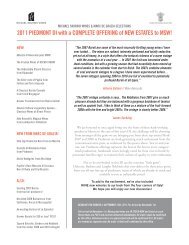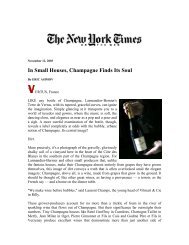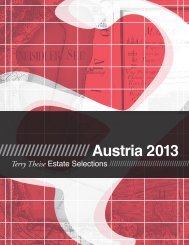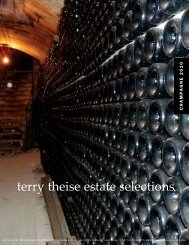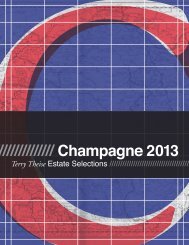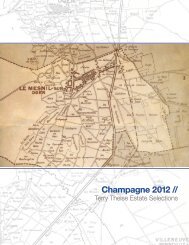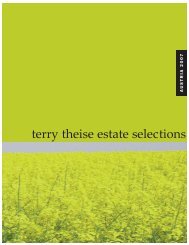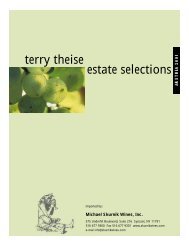German Catalog 2006 USE THIS ONE.qxp - Michael Skurnik Wines
German Catalog 2006 USE THIS ONE.qxp - Michael Skurnik Wines
German Catalog 2006 USE THIS ONE.qxp - Michael Skurnik Wines
Create successful ePaper yourself
Turn your PDF publications into a flip-book with our unique Google optimized e-Paper software.
pulled up. After the new roads are built and the work is<br />
completed (sometimes old walls and terraces are rebuilt<br />
also), the growers get the same amount of land back, or<br />
nearly, but in fewer, larger sections. After replanting, the<br />
first commercial crop follows in three to four years.<br />
Everyone who’s had vineyards through the process<br />
reports that it is much easier to work the land afterwards.<br />
It also levels the playing field, since everybody’s vines<br />
are now the same age. It does create short-term shortages<br />
of wine, and it does diminish the quality of wine<br />
from a vineyard until the vines mature again, but it’s a<br />
small price to pay to help ensure the future of viticulture<br />
in <strong>German</strong>y.<br />
But here’s a curious twist. Every parcel of vineyards in<br />
<strong>German</strong>y is categorized by quality — categories A, B, or C<br />
— so that when the vineyards are reapportioned the grower<br />
gets back nearly the same proportions of A B and C land<br />
he gave up. Makes sense. But also raises a very sneaky<br />
question: Why does anyone still quarrel with the idea of a<br />
vineyard classification when it has already been done?? And<br />
is already being used! Show me a grower who fumes that<br />
vineyard classifications are undemocratic and I’ll show<br />
you a grower who’ll fuss to high hell if he gives up A-land<br />
and gets B-land back.<br />
HOCHGEWÄCHS: Do us both a favor and don’t even<br />
try to pronounce this. Just do what I do and call it “hogwash,”<br />
for that’s what it is. Another perfect example of<br />
an idea that started out right and turned into a bureaucratic<br />
nightmare. Here’s the scenario. You’re a conscientious<br />
grower; a lot of your wines exceed the legal minimum<br />
for their quality levels. Especially your QbA<br />
wines, which are near or actually at Kabinett ripeness.<br />
You don’t want to make a thin Kabinett from these<br />
grapes, so you chaptalize. No problem so far. Except that<br />
when you try to sell the wine, now labeled QbA, it competes<br />
against oceans of mass-produced, cheap, lowestcommon-denominator<br />
QbA selling for pennies per bottle<br />
at the corner supermarket. Nobody will pay your<br />
price. Where’s your incentive?<br />
Thus the creation of this new term (actually the co-opting<br />
of an earlier term with a different meaning, but that’s<br />
another story). Think of it as a kind of “super QbA,” or it<br />
you prefer, a chaptalized Kabinett or damn-near Kabinett.<br />
Any chaptalized wine with at least x-ripeness can be sold<br />
as Hochgewächs. You can even chaptalize Spätlese quality<br />
must if you feel like it. Hogwash also has special<br />
requirements in terms of how many points the wine<br />
needs in order to qualify, and, most significant, one hundred<br />
percent purity of vintage, grape variety and vineyard<br />
site—versus 85% as the general rule in <strong>German</strong>y.<br />
So you can see why they needed to do it, but the thing<br />
is just so typically half-assed! Why don’t they show some<br />
courage and raise the requirements for Qualitätswein?<br />
Easy answer: because the merchants and co-ops have too<br />
much political clout. But hey, no problem, dude! I don’t<br />
mind struggling my entire career to erase the miserable<br />
impression so many people have of <strong>German</strong> wine<br />
because of all the oceans of bilge those wineries turn out!<br />
GUTSABFÜLLUNG: This is a recently permitted term<br />
for estate bottling, and much preferable to the old<br />
Erzeugerab-füllung which is now restricted for use by<br />
co-ops. This is good for at least two reasons. First the<br />
word is shorter. Second, it creates a logical connection<br />
between Weingut and Gutsabfüllung. And third, we’uns<br />
can remember it because, after all, it means to fill your<br />
gut! ‘Bout time the <strong>German</strong>s did something good with<br />
their Twilight-Zone wine law.<br />
THEIR TWILIGHT-Z<strong>ONE</strong> WINE LAW: The 1971 wine<br />
law is being neutered by the new generation. Eventually<br />
it will become so irrelevant to the way wines are actually<br />
produced and labeled it will either be forced to adapt to<br />
reality or become a laughable anachronism. Many growers<br />
are taking their cue from the Austrians: all the dry<br />
wines are ostensibly sold as “QbA” because no one likes<br />
“Spätlese Trocken” or “Auslese Trocken”. Many growers<br />
are using old micro-site names as a gesture of recognition<br />
to their distinctive terroirs. No serious grower cares (nor<br />
do some of them even know) about the ripeness minima<br />
for the various “Prädikat” levels; they name by taste, and<br />
a “Kabinett” is the wine that tastes like one, regardless of<br />
must-weight. Indeed there’s never been less concern<br />
about must-weight, or more concern about physiological<br />
ripeness.<br />
So I asked a few of the wise old sages whether they<br />
thought the law could be changed. The consensus is: no.<br />
Far too complicated and messy, especially now that the<br />
EU is involved. What will happen, they say, is far more<br />
growers will take what’s useful in the law and disregard<br />
the rest.<br />
FEINHERB: There must have been a hole in the ozone<br />
layer when they permitted this term to be used. Because<br />
they didn’t control it, and this is most scandalously fungible,<br />
sensible and un-Teutonic. In fact feinherb means<br />
whatever a grower wants it to mean. It always denotes a<br />
wine on-the-dry-side, and in practice, as one grower told<br />
me, the local wine-inspector tolerates anything up to<br />
30g.l. residual sugar especially if the wines tastes as if it<br />
should have 70. For some growers feinherb are their dryish<br />
wines above the limit for Halbtrocken. Others use it<br />
in place of Halbtrocken because(correctly) they despise<br />
“Halbtrocken”.<br />
When I first started seriously with wine, herb was the<br />
word growers used to indicate their dry (or dry-er)<br />
wines. “Trocken” was unknown. So “feinherb” is an<br />
attempt to rub a little spit on it and make it sound nice.<br />
The word is neither here nor there, but the idea of regulating<br />
it sensorily is so manifestly sensible I wonder why<br />
they don’t apply it to all the dry wines instead of obsessing<br />
over lab figures. Enjoy this wee glimmer of sanity<br />
while it lasts, as I’m sure some constipated twit at E.U.<br />
Brussels HQ will wrestle it into his airless little box.<br />
35


